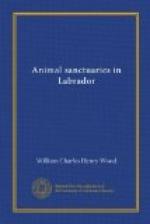But in spite of all these and many other difficulties, I firmly believe that Labrador is by far the best country in the world for the best kinds of sanctuary. The first time you’re on a lee shore there, in a full gale, you may well be excused for shrinking back from the wild white line of devouring breakers. But when you actually make for them you find the coast opening into archipelagoes of islands, to let you safely through into the snug little “tickles,” between island and mainland, where you can ride out the storm as well as you could in a landlocked harbour. This is typical of many another pleasant surprise. Labrador decidedly improves on acquaintance. The fogs have been grossly exaggerated. The Atlantic seaboard is clearer than the British Isles, which, by the way, lie in exactly the same latitudes. And the Gulf is far clearer than New Brunswick, Nova Scotia and the Banks. The climate is exceptionally healthy, the air a most invigorating tonic, and the cold no greater than in many a civilized northern land. Besides, there is a considerable range of temperatures in a country whose extreme north and south lie 1,000 miles apart, one in the latitude of Greenland, the other in that of Paris. Taking the Labrador peninsula geographically, as including the whole area east of a line run up the Saguenay and on from lake St. John to James bay, it comprises 560,000 square miles—eleven Englands! The actual residents hardly number 20,000. About twice as many outsiders appear off the coasts at certain seasons. So it would take a tenfold increase, afloat and ashore, to make one human being to each square mile of land. But, all the same, wild life needs conservation there, and needs it badly, as we shall presently see.
Most of Labrador is a rocky tableland, still rising from the depths, with some old beaches as much as 1,500 feet above the present level of the sea. The St. Lawrence seaboard is famous for its rivers and forests. The Atlantic seaboard has the same myriads of islands, is magnificently bold, is pierced by fiords unexcelled in Norway, and crowned by mountains higher than any others east of the Rockies. Hamilton inlet runs in 150 miles. At Ramah the cliffs rise sheer three thousand five hundred feet and more. The Four peaks, still untrodden by the foot of man, rise more than twice as high again. And the colouration, of every splendid hue, adds beauty to the grandeur of the scene. Inland, there are lakes up to 100 miles long, big rivers by the score, deep canyons and foaming rapids—to say nothing of the countless waterfalls, of which the greatest equals two Niagaras. This vast country is accessible by sea on three sides, and will soon be accessible by land on the fourth. It lies directly half-way between Great Britain and our own North West and is 1,000 miles nearer London than New York is. Its timber, mines and water-power will be increasingly exploited. It should also become increasingly attractive to the best type of tourist, naturalist




